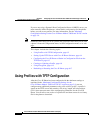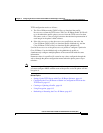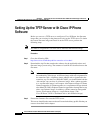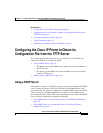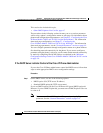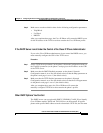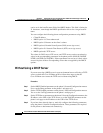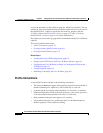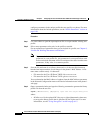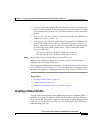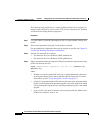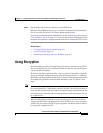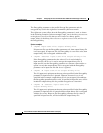
6-9
Cisco IP Phone Models 7905G and 7912G Administrator Guide (SIP)
OL-4277-01
Chapter 6 Configuring the Cisco IP Phone Models 7905G and 7912G Using a TFTP Server
Creating or Updating a Profile
• IP Address
• Network gateway (default router)
• Subnet Mask
You may also provide other parameters that are normally supplied by DHCP by
configuring their values. These parameters are:
• DNS Server 1
• DNS Server 2
• NTP Server 1
• NTP Server 2
• Domain Name
After you complete these steps, the Cisco IP Phone will be able to contact the
TFTP server (without using DHCP) that will contain the configuration file for the
phone.
Related Topics
• Using Profiles with TFTP Configuration, page 6-2
• Setting Up the TFTP Server with Cisco IP Phone Software, page 6-4
• Creating or Updating a Profile, page 6-9
• Using Encryption, page 6-15
• Refreshing or Resetting the Cisco IP Phone, page 6-17
Creating or Updating a Profile
The profile from which a Cisco IP Phone obtains information is a binary file.
However, when you create or edit a profile, you work with a text version of the
file, then create a binary version from the text file. Before you can create a binary
profile, you will need the cfgfmt.exe tool, which converts a text profile file to
binary format.
The cfgfmt.exe tool requires a parameter tag file, which specifies the type and size
of each parameter. By default, the cfgfmt.exe tool looks in the folder from which
you run the tool for a parameter tag file named ptag.dat. Cisco recommends that




